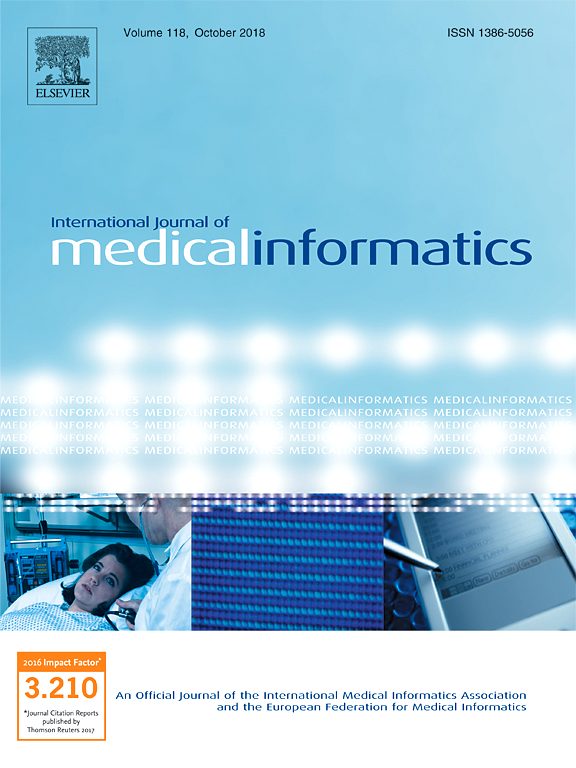Editorial Board
The emerging role of cognitive computing in healthcare: A systematic literature review
Determinants and outcomes of patient access to medical records: Systematic review of systematic reviews
Passive data collection and use in healthcare: A systematic review of ethical issues
The impact of electronic meal ordering systems on hospital and patient outcomes: A systematic review
Prescriber perceptions of medication-related computerized decision support systems in hospitals: A synthesis of qualitative research
Factors influencing seniors’ acceptance of technology for ageing in place in the post-implementation stage: A literature review
The seven key challenges for the future of computer-aided diagnosis in medicine
HypernasalityNet: Deep recurrent neural network for automatic hypernasality detection
Identification and analysis of behavioral phenotypes in autism spectrum disorder via unsupervised machine learning
Health information technology use and influenza vaccine uptake among US adults
Characteristics of office-based providers associated with secure electronic messaging use: Achieving meaningful use
A wearable approach for intraoperative physiological stress monitoring of multiple cooperative surgeons
The false vital sign: When pain levels are not predictive of discharge opioid prescriptions
A mobile app for postoperative wound care after arthroplasty: Ease of use and perceived usefulness
Cognitive requirements for primary care providers during the referral process: Information needed from and interactions with an electronic health record system
Spanish adaptation and validation of the Mobile Application Rating Scale questionnaire
Incorporating symptom data in longitudinal disease trajectories for more detailed patient stratification
Semantic preservation of standardized healthcare documents in big data
Strengths, pitfalls, and lessons learned in implementing electronic collection of childhood vaccination data in Zambia: The SmartCare experience
Short and Long term predictions of Hospital emergency department attendances
Machine learning approaches for risk assessment of peripherally inserted Central catheter-related vein thrombosis in hospitalized patients with cancer
Prediction of emergency department patient disposition based on natural language processing of triage notes
ICD-10-CM extension with ICD-9 diagnosis codes to support integrated access to clinical legacy data
A decision support system for predicting the treatment of ectopic pregnancies
Prediction of emergency department revisits using area-level social determinants of health measures and health information exchange information
Adapting and validating informatics competencies for senior nurse leaders in the Canadian context: Results of a Delphi study
The implementation of a synchronous telemedicine platform linking off-site pediatric intensivists and on-site fellows in a pediatric intensive care unit: A feasibility study
Mining patient-specific and contextual data with machine learning technologies to predict cancellation of children’s surgery
The impact of improving the quality of coding in the utilities of Diagnosis Related Groups system in a private healthcare institution. 14-year experience
A cross-country time and motion study to measure the impact of electronic medication management systems on the work of hospital pharmacists in Australia and England
Trends in e-visit adoption among U.S. office-based physicians: Evidence from the 2011–2015 NAMCS
Sharing health data among general practitioners: The Nu.Sa. project
Performance of primary healthcare dentists in a distance learning course in pediatric dentistry
Persistence of data-driven knowledge to predict breast cancer survival
The implementation of an electronic health record: Comparing preparations for Epic in Norway with experiences from the UK and Denmark
Improving mortality models in the ICU with high-frequency data
Augmented intelligence with natural language processing applied to electronic health records for identifying patients with non-alcoholic fatty liver disease at risk for disease progression
Electronic Health Record implementation in a large academic radiotherapy department: Temporarily disruptions but long-term benefits
Guidetomeasure-OT: A mobile 3D application to improve the accuracy, consistency, and efficiency of clinician-led home-based falls-risk assessments
Eye-tracking retrospective think-aloud as a novel approach for a usability evaluation
Text preprocessing for improving hypoglycemia detection from clinical notes – A case study of patients with diabetes
Unpacking telemonitoring work: Workload and telephone calls to patients in implanted cardiac device care
Feasibility of a voice-enabled automated platform for medical data collection: CardioCube
Modelling the interactive behaviour of users with a medication safety dashboard in a primary care setting
A pilot study of a smartphone-based monitoring intervention on head and neck cancer patients undergoing concurrent chemo-radiotherapy
Impact of EHR-based rounding tools on interactive communication: A prospective observational study
Electronic health records implementation in Morocco: Challenges of silo efforts and recommendations for improvements
Automatic trial eligibility surveillance based on unstructured clinical data
Categorization of free-text drug orders using character-level recurrent neural networks
Interpretable deep learning to map diagnostic texts to ICD-10 codes
Identifying incidental findings from radiology reports of trauma patients: An evaluation of automated feature representation methods
Measuring the effect of different types of unsupervised word representations on Medical Named Entity Recognition
Extractive summarization of clinical trial descriptions
Classifying adverse drug reactions from imbalanced twitter data
Erratum to “Cognitive requirements for primary care providers during the referral process: Information needed from and interactions with an electronic health record system” [Int. J. Med. Inform. 129 (2019) 88–94]


